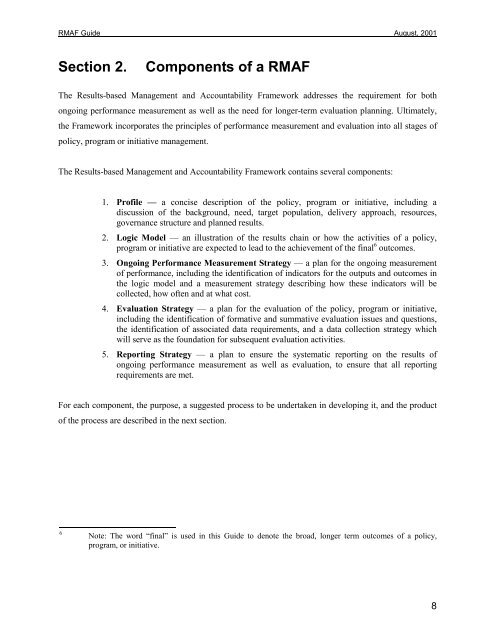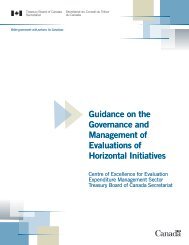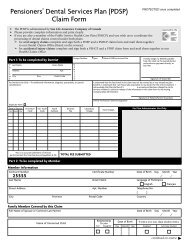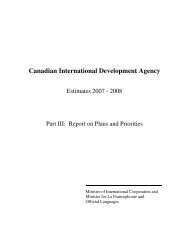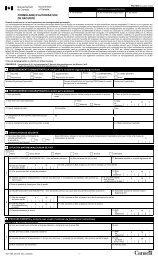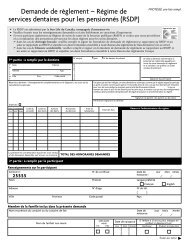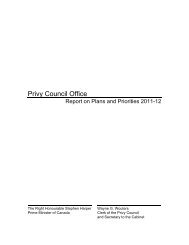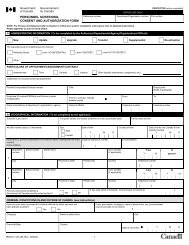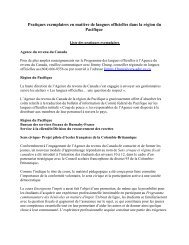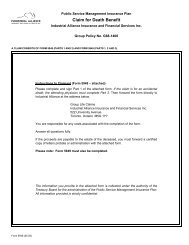Guide for the Development of Results-based Management and ...
Guide for the Development of Results-based Management and ...
Guide for the Development of Results-based Management and ...
You also want an ePaper? Increase the reach of your titles
YUMPU automatically turns print PDFs into web optimized ePapers that Google loves.
RMAF <strong>Guide</strong> August, 2001Section 2.Components <strong>of</strong> a RMAFThe <strong>Results</strong>-<strong>based</strong> <strong>Management</strong> <strong>and</strong> Accountability Framework addresses <strong>the</strong> requirement <strong>for</strong> bothongoing per<strong>for</strong>mance measurement as well as <strong>the</strong> need <strong>for</strong> longer-term evaluation planning. Ultimately,<strong>the</strong> Framework incorporates <strong>the</strong> principles <strong>of</strong> per<strong>for</strong>mance measurement <strong>and</strong> evaluation into all stages <strong>of</strong>policy, program or initiative management.The <strong>Results</strong>-<strong>based</strong> <strong>Management</strong> <strong>and</strong> Accountability Framework contains several components:1. Pr<strong>of</strong>ile — a concise description <strong>of</strong> <strong>the</strong> policy, program or initiative, including adiscussion <strong>of</strong> <strong>the</strong> background, need, target population, delivery approach, resources,governance structure <strong>and</strong> planned results.2. Logic Model — an illustration <strong>of</strong> <strong>the</strong> results chain or how <strong>the</strong> activities <strong>of</strong> a policy,program or initiative are expected to lead to <strong>the</strong> achievement <strong>of</strong> <strong>the</strong> final 6 outcomes.3. Ongoing Per<strong>for</strong>mance Measurement Strategy — a plan <strong>for</strong> <strong>the</strong> ongoing measurement<strong>of</strong> per<strong>for</strong>mance, including <strong>the</strong> identification <strong>of</strong> indicators <strong>for</strong> <strong>the</strong> outputs <strong>and</strong> outcomes in<strong>the</strong> logic model <strong>and</strong> a measurement strategy describing how <strong>the</strong>se indicators will becollected, how <strong>of</strong>ten <strong>and</strong> at what cost.4. Evaluation Strategy — a plan <strong>for</strong> <strong>the</strong> evaluation <strong>of</strong> <strong>the</strong> policy, program or initiative,including <strong>the</strong> identification <strong>of</strong> <strong>for</strong>mative <strong>and</strong> summative evaluation issues <strong>and</strong> questions,<strong>the</strong> identification <strong>of</strong> associated data requirements, <strong>and</strong> a data collection strategy whichwill serve as <strong>the</strong> foundation <strong>for</strong> subsequent evaluation activities.5. Reporting Strategy — a plan to ensure <strong>the</strong> systematic reporting on <strong>the</strong> results <strong>of</strong>ongoing per<strong>for</strong>mance measurement as well as evaluation, to ensure that all reportingrequirements are met.For each component, <strong>the</strong> purpose, a suggested process to be undertaken in developing it, <strong>and</strong> <strong>the</strong> product<strong>of</strong> <strong>the</strong> process are described in <strong>the</strong> next section.6Note: The word “final” is used in this <strong>Guide</strong> to denote <strong>the</strong> broad, longer term outcomes <strong>of</strong> a policy,program, or initiative.8


